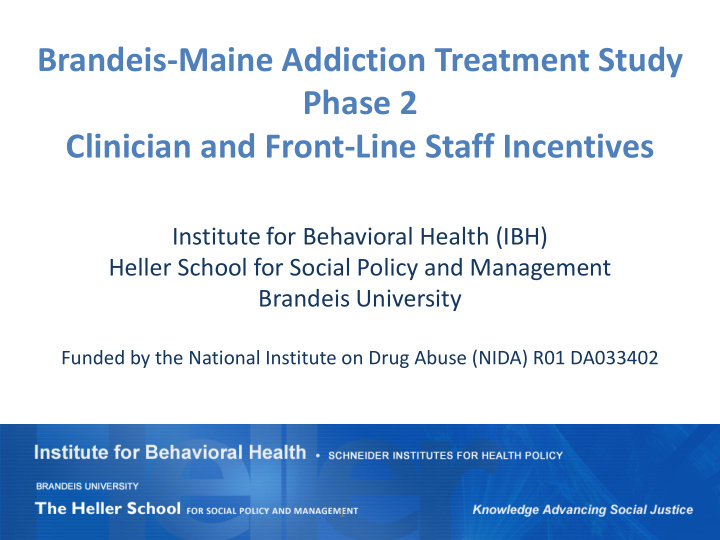



Brandeis-Maine Addiction Treatment Study Phase 2 Clinician and Front-Line Staff Incentives Institute for Behavioral Health (IBH) Heller School for Social Policy and Management Brandeis University Funded by the National Institute on Drug Abuse (NIDA) R01 DA033402 1
How to reach us: • Margot Davis, margotd@brandeis.edu, 781-736-3850 • Maria Torres, mtorres@brandeis.edu, 781-736-4836 • Project Director: Maureen Stewart, mstewart@brandeis.edu, 781-736-3717 • Principal Investigator: Sharon Reif reif@brandeis.edu, 781-736-3924 • IRB (human subjects): irb@brandeis.edu, 781-736-8133 • For more info: http://sihp.brandeis.edu/ibh/maine-incentives/index.html
Why we are doing this study • Despite tremendous efforts, quality of SUD treatment has room for improvement • Incentives (to the program, clinician, client) may lead to behavior change that can improve quality – Questions remain about effects in SUD treatment – Little is known about incentives to clinicians and other staff in SUD treatment this is an exciting opportunity to be at the forefront 3
Why we are doing this study in Maine • You have experience and knowledge that could benefit each other and providers elsewhere • You have a history of quality initiatives (e.g., NIATx, STAR-SI) • SAMHS has a long history of pioneering payment methods and research collaboration We can learn from your experience and knowledge about quality and incentives, within this context of activated providers and treatment system 4
How is the study set up? Overall question: Do financial incentives paid directly to clinicians and front line staff improve performance? What is the goal? Improve access to treatment and retention in treatment • Who can participate? All staff with direct client contact, including • clinicians, receptionists, intake counselors, psychiatrists, etc. Will all programs get an incentive? We randomized participating programs • to the clinician incentive group or the control group (no clinician incentive). – Your program is in the incentive group – you are eligible to receive incentives based on your program’s performance What do I need to do? No required changes – what you do is up to you. • How long does the study last? Nearly 1 year (or 3.5 quarters) – Feb 15, • 2015 to Dec 31, 2015 Who is paying for the study? All funds come from the research project, not • SAMHS or your program. The overall study is funded by the National Institute on Drug Abuse (NIDA) 5
What to expect if you participate The study team will: Measure your program performance quarterly, using admission • and discharge data you already send to SAMHS – We use 3 performance measures: access to treatment, early retention and retention (see next slide) Determine if your program met targets or improved in each • quarter, compared to your program’s 2013 baseline Send $$ (a check) to each participating individual, about 4 weeks • after the end of each quarter – Only paid if the program meets at least one target or improves on at least one measure Ask you to complete a web-based survey soon after the study • begins and just after the study ends. You will get $25 for each survey you complete, whether or not you receive an incentive 6
OUTPATIENT PROGRAMS High Improvement Target from Baseline Target Level Required for Reward ($50) ($5) ($30) each 1 day Access (time from 1 st contact to 1 st treatment) 10 days 5 days decrease 71% of 90% of each 2% Early retention (4 or more sessions) admissions admissions increase 42% of 65% of each 2% Retention (90 days or more) admissions admissions increase All data are for the whole program, not individual staff. “Target” is the 50 th percentile of all outpatient programs in Maine in 2013. For example, half of all outpatient programs in Maine had an average of 10 days between 1 st contact and 1 st treatment, across all of their outpatient clients. “High target” is the 90 th percentile. The top 10% of programs had an average of 5 days from 1 st contract to 1 st treatment in 2013.
INTENSIVE OUTPATIENT PROGRAMS High Improvement Target from Baseline Target Level Required for Reward ($50) ($5) ($30) each 1 day Access (time from 1 st contact to 1 st treatment) 7 days 2 days decrease 82% of 97% of each 2% Early retention (4 or more sessions) admissions admissions increase 42% of 65% of each 2% Retention (treatment completion) admissions admissions increase All data are for the whole program, not individual staff. “Target” is the 50 th percentile of all intensive outpatient programs in Maine in 2013. For example, half of all IOP programs in Maine had an average of 7 days between 1 st contact and 1 st treatment, across all of their outpatient clients. “High target” is the 90 th percentile. The top 10% of programs had an average of 2 days from 1 st contract to 1 st treatment in 2013.
Example using 4+ sessions 2013 2015 1 st Quarter Baseline $50 for high target + 79% 91% $60 for 6x2% improvement = $110 to each participating clinician $0 (didn’t meet target) + 35% 45% $50 (5x2% improvement) = $50 to each participating clinician $30 for target + 72% 72% $0 (no improvement) = $30 to each participating clinician $0 (didn’t meet target) + 35% 35% $0 (no improvement) = $0 $30 for target + $0 (no improvement) 78% 72% =$30 to each participating clinician 9
How did your program do? AGENCY NAME – Outpatient 1 st Quarter (Feb-Mar 2015) Early Access Retention Retention 2013 BASELINE 12 days 80% 41% THIS QUARTER 12 days 92% 45% $ for Target: $0 $50 $30 $ for $0 $60 $20 Improvement: Total $ $0 $110 $50 R = $0 + $110 + $50 = $160 YOUR RE WARD F OR T HIS QUART E
Recommend
More recommend